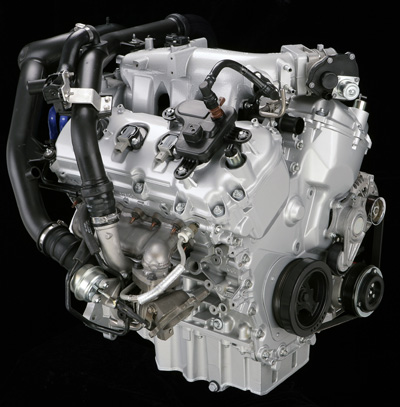By Ed Sunkin
With the uncertainty of fuel prices and the concern that gasoline could again top $4 a gallon across the nation, Americans have been shifting their vehicle-buying behaviors toward more fuel-efficient vehicles.
While gasoline-electric hybrid vehicles have been getting much of the attention as the next step in fuel-sipping vehicles, turbocharging — which is used by roughly half of new vehicles in Europe — is emerging as an engine technology U.S. consumers “didn’t know they wanted.”
In a recent study of U.S. consumers by Honeywell, more than half of those who plan to purchase a vehicle in the next two years believe fuel efficiency is more important than it was during their last vehicle purchase. The study also found that more than 80% of American consumers were more likely to consider purchasing a turbocharged vehicle after learning that the readily available turbocharger helps to increase the fuel efficiency of a gas engine by up to 20%, without sacrificing performance or reliability.
According to David Paja, vice president, marketing for Honeywell Turbo Technologies, the recent “Cash for Clunkers” program also was a good indicator for automakers to incorporate turbo technology into today’s vehicles. According to the U.S. Department of Transportation, nine out of the 10 most popular vehicles purchased in the program were equipped with smaller, more fuel-efficient versions of conventional technology engines.
“For that reason, almost every major automaker has announced plans to broadly introduce turbocharged engines to the U.S. market in the coming years. We anticipate demand for gas and diesel turbocharged engines in the U.S. market may increase from 5% today to 25% by 2014, and could top 85% by 2020,” Paja said.
While turbocharging an engine is nothing new (Volvo, Saab, Audi, Porsche, Volkswagen, Subaru and even Chrysler have produced turbocharged cars for years), today’s turbo technology has seen much improvement over previous generations.
Automotive technicians who have serviced these vehicles know that turbochargers can be damaged by dirty or ineffective oil. In fact, most manufacturers recommend more frequent oil changes for turbocharged engines. This is an issue, as more and more drivers seem to be inching up in miles driven between oil changes.
One way to combat that problem is selling their customers synthetic oils, which tend to flow more readily when cold and do not break down as quickly as conventional oils.
And, because the turbocharger will heat when running, some OEs recommend letting the engine idle for one to three minutes before shutting off the engine if the turbocharger was used shortly before stopping. In fact, most manufacturers determined a 10-second period of idling before switching off to ensure the turbocharger is running at its idle speed would prevent damage to the bearings when the oil supply is cut off.
While some in the industry saw problems, another OE saw potential. Recently, Ford Motor Co. began introducing a twin-turbocharged, 365-hp 3.5L V6 EcoBoost engine into its vehicle lineup. Ford says these twin turbochargers
harness exhaust gas to pump V8 power out of the smaller-displacement EcoBoost V6 engine. This technology — in conjunction with direct fuel injection — allows EcoBoost to punch above its size in terms of power and responsiveness.
According to Ford engineers, the EcoBoost engine has been designed with such refinement that the driver never notices the turbocharger operation. Sophisticated electronic controls balance boost and torque levels to give the driver the feeling of continuous torque delivery, without turbo “whines” and “whooshes” that characterized some previous-generation turbo engines.
And even though the EcoBoost turbo system runs at a very high temperature (1,740° F), an air-to-air intercooler is used to cool the compressed intake air before it enters the combustion chamber, and water cooling protects the internal turbo bearings in the high-temperature operating environment.
Ford’s advanced engine engineers explained that the use of these water-cooled turbochargers combats oil coking. “During normal turbo operation, the turbo receives most of its bearing cooling through oil,” said Keith Plagens, turbo system engineer.
“After shut down, the problems with turbos in the past were you would get coking in the center bearing — oil would collect in the bearings, the heat soaks in and the oil would start to coke on the side and foul the bearing. Water cooling eliminates that worry because the EcoBoost engine uses passive thermal siphoning for water cooling," Plagens said.
Plagens explained that during normal engine operation, the engine’s water pump cycles coolant through the center bearing. After engine shutdown renders the water pump inactive, the coolant flow reverses — coolant heats up and flows away from the turbocharger water jacket, pulling fresh, cool coolant in behind.
Ford believes this combination of direct fuel injection (similar to what is used in diesel applications) coupled with turbocharging, is the wave of the future for powerful, fuel-efficient vehicles. By 2013, more than 90% of Ford’s North American lineup will be available with EcoBoost technology.
The engineers at Ford may be on to something. The EcoBoost engine was honored last month with a Popular Mechanics Breakthrough Award at a ceremony at the Hearst Tower in New York City. The Popular Mechanics Breakthrough Awards, now in their fifth year, recognize products and celebrate innovations poised to change the world. Ford was the only automaker this year to receive a Breakthrough Award.
NOTE: For an in-depth look at Ford’s EcoBoost engine, check out technicial contributor Glen Beanard’s article by clicking here: http://www.underhoodservice.com/Article/68338/tech_feature_engine_technology_gets_a_boost.aspx.












